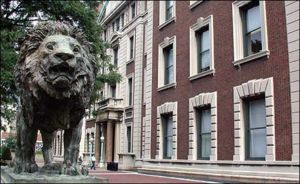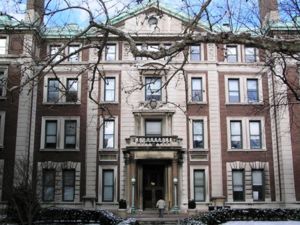Difference between revisions of "Havemeyer Hall"
| Line 12: | Line 12: | ||
The east end of Haveyemer's main corridor was once devoted to Chandler's Chemical Museum, which held every inorganic salt known at the time and a collection of more than 4000 organic compounds, 1000 of them first developed in Columbia laboratories, as well as vegetable, petroleum and essential oils; explosives dating back to the Civil War; tanning and fertilizer exhibits; resins, varnishes, and pigments; a comprehensive electrochemical exhibit; colloids; a collection showing the history of ceramic arts; a set of early-19th century apothecary jars; a collection of the earliest photographs; and an exhibit of "rare earths". There was also a set of pre-World War I German dyes. The Chandler Museum collection was the only one available for use by the U.S. government for standards after German dye patents were confiscated during the war. Much of the content of the museum survives, though only a small portion is on display in Havemeyer's corridors. | The east end of Haveyemer's main corridor was once devoted to Chandler's Chemical Museum, which held every inorganic salt known at the time and a collection of more than 4000 organic compounds, 1000 of them first developed in Columbia laboratories, as well as vegetable, petroleum and essential oils; explosives dating back to the Civil War; tanning and fertilizer exhibits; resins, varnishes, and pigments; a comprehensive electrochemical exhibit; colloids; a collection showing the history of ceramic arts; a set of early-19th century apothecary jars; a collection of the earliest photographs; and an exhibit of "rare earths". There was also a set of pre-World War I German dyes. The Chandler Museum collection was the only one available for use by the U.S. government for standards after German dye patents were confiscated during the war. Much of the content of the museum survives, though only a small portion is on display in Havemeyer's corridors. | ||
| − | == | + | == Tunnel connections == |
| − | + | Havemeyer is connected to [[Chandler Hall]] from which one can gain access to the tunnels (specifically, the Old Powerplant tunnel system). Connected to [[Mathematics Hall]], but the door is locked from one side. | |
| − | |||
| − | |||
== Map == | == Map == | ||
| Line 23: | Line 21: | ||
40.809294, -73.962064, Havemeyer Hall | 40.809294, -73.962064, Havemeyer Hall | ||
</googlemap> | </googlemap> | ||
| + | |||
| + | == External links == | ||
| + | |||
| + | * [http://www.columbia.edu/about_columbia/tour/18.html Havemeyer on the online campus tour] | ||
| + | * [http://acswebcontent.acs.org/landmarks/landmarks/hav/index.html Havemeyer on the National Historic Chemical Landmarks website] | ||
| + | * [http://www.columbia.edu/cu/record/archives/vol22/vol22_iss8/record2208.22.html 100 Years of History in Havemeyer - Columbia University Record November 1, 1996 -- Vol. 22, No. 8 ] | ||
[[Category:Buildings on the Morningside Heights campus]] | [[Category:Buildings on the Morningside Heights campus]] | ||
Revision as of 17:44, 7 March 2008

Havemeyer Hall is the home of the Chemistry Department. It was the vision of chemist Charles Frederick Chandler, and was funded by his friend Theodore Havemeyer (School of Mines Class of 1868) in honor of his father, Frederick Christian Havemeyer (Columbia College Class of 1825). The family made its fortune in the sugar industry. The building was built between 1896 and 1898.
Research done here has led to seven Nobel Prizes. The first was awarded in 1934 to Harold Clayton Urey, whose research in Havemeyer led to the discovery of deuterium in 1931. Urey's old office (622) is occupied by Professor Louis E. Brus, the Samuel Latham Mitchell Professor of Chemistry and Professor of Chemical Engineering.
Room 309, a huge lecture hall that is the building's centerpiece, is famous for being featured in a number of films.
Exhibits
The east end of Haveyemer's main corridor was once devoted to Chandler's Chemical Museum, which held every inorganic salt known at the time and a collection of more than 4000 organic compounds, 1000 of them first developed in Columbia laboratories, as well as vegetable, petroleum and essential oils; explosives dating back to the Civil War; tanning and fertilizer exhibits; resins, varnishes, and pigments; a comprehensive electrochemical exhibit; colloids; a collection showing the history of ceramic arts; a set of early-19th century apothecary jars; a collection of the earliest photographs; and an exhibit of "rare earths". There was also a set of pre-World War I German dyes. The Chandler Museum collection was the only one available for use by the U.S. government for standards after German dye patents were confiscated during the war. Much of the content of the museum survives, though only a small portion is on display in Havemeyer's corridors.
Tunnel connections
Havemeyer is connected to Chandler Hall from which one can gain access to the tunnels (specifically, the Old Powerplant tunnel system). Connected to Mathematics Hall, but the door is locked from one side.
Map
<googlemap lat="40.809294" lon="-73.962064" type="map" zoom="16" width="500" height="300" controls="small"> 40.809294, -73.962064, Havemeyer Hall </googlemap>
